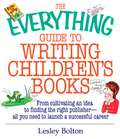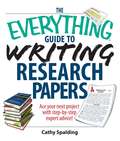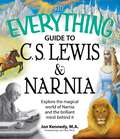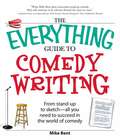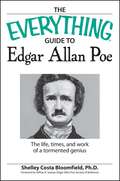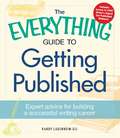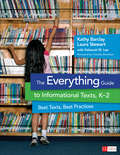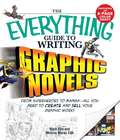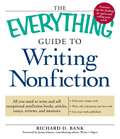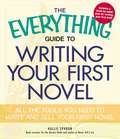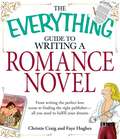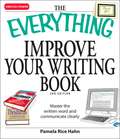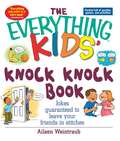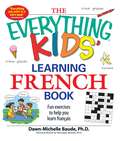- Table View
- List View
The Everything Guide To Writing Children's Books
by Lesley BoltonThe Everything Guide to Writing Children's Books is the perfect handbook if you're looking to create a successful children's book. From generating a sellable idea to turning in your manuscript, The Everything Guide to Writing Children's Books is packed with information that can help your publishing dreams come true. The Everything Guide to Writing Children's Books includes all the necessary facts you need to conquer the children's book industry, including tips on getting started and hints on writing to the correct age group. In addition, the book features up-to-date information on publishers that specialize in children's books, writing workshops and seminars, and marketing and publicity. It is a must-have for aspiring writers everywhere! Lesley Bolton is a freelance writer and professional editor. She has a B.F.A. in writing, literature, and publishing from Emerson College, where she specialized in children's books.
The Everything Guide To Writing Children's Books: From Cultivating an Idea to Finding the Right Publisher All You Need to Launch a Successful Career
by Lesley BoltonA Simon & Schuster eBook. Simon & Schuster has a great book for every reader.
The Everything Guide To Writing Research Papers Book
by Cathy SpaldingThat important paper is due soon and you don't know where to start. You're out of ideas and out of time. Don't panic-- writing great research papers is not as daunting a task as you think. It's just a process--and with The Everything Guide to Writing Research Papers, you can master that process in no time.Professional educator and writer Cathy Spalding guides you step -by-step through the writing process--from brainstorming ideas to polishing your final work. With dozens of timesaving tips on organization, research, and revision, you'll find the actual writing easier than ever before.This easy-to-follow handbook answers all of your questions: What are the different types of research papers--and which should you write? How can you focus your research efforts, saving time and aggravation? Yikes! You're three pages short - now what? What can you do to protect yourself from plagiarism? How do you find and cite all of your sources? Perfect for high school and college students juggling multiple assignments, The Everything Guide to Writing Research Papers shows you how to take control of your assignments - before they take control of you!
The Everything Guide To Writing Research Papers Book: Ace Your Next Project With Step-by-step Expert Advice!
by Cathy SpaldingThat important paper is due soon and you don’t know where to start. You’re out of ideas and out of time. Don’t panic-- writing great research papers is not as daunting a task as you think. It’s just a process—and with The Everything Guide to Writing Research Papers, you can master that process in no time.Professional educator and writer Cathy Spalding guides you step –by-step through the writing process—from brainstorming ideas to polishing your final work. With dozens of timesaving tips on organization, research, and revision, you’ll find the actual writing easier than ever before.This easy-to-follow handbook answers all of your questions:What are the different types of research papers—and which should you write?How can you focus your research efforts, saving time and aggravation?Yikes! You’re three pages short – now what?What can you do to protect yourself from plagiarism?How do you find and cite all of your sources?Perfect for high school and college students juggling multiple assignments, The Everything Guide to Writing Research Papers shows you how to take control of your assignments – before they take control of you!
The Everything Guide to C.S. Lewis & Narnia
by Jon KennedyNow, more than ever, the works of C.S. Lewis enthrall and entertain readers of all ages. But who was this man of intellect and imagination? The Everything C.S. Lewis and Narnia Book gives you an in-depth look at this master storyteller, his life and times, and his best known works. You’ll learn how he: Overcame his tragic childhood Journeyed from atheism to faith Created the magical world of Narnia Inspired other writers, philosophers, and political thinkers Found—and tragically lost—the love of his life You’ll also gain a deeper understanding of Lewis’s body of literary works including the enchanting characters of Narnia. This is the essential guide to the man who inspired the imaginations of millions of children and adults alike!
The Everything Guide to C.S. Lewis & Narnia Book
by Jon KennedyNow, more than ever, the works of C.S. Lewis enthrall and entertain readers of all ages. But who was this man of intellect and imagination? The Everything C.S. Lewis and Narnia Book gives you an in-depth look at this master storyteller, his life and times, and his best known works. You'll learn how he: Overcame his tragic childhood Journeyed from atheism to faith Created the magical world of Narnia Inspired other writers, philosophers, and political thinkers Found--and tragically lost--the love of his life You'll also gain a deeper understanding of Lewis's body of literary works including the enchanting characters of Narnia. This is the essential guide to the man who inspired the imaginations of millions of children and adults alike!
The Everything Guide to C.S. Lewis & Narnia Book: Explore the magical world of Narnia and the brilliant mind behind it
by Jon KennedyNow, more than ever, the works of C.S. Lewis enthrall and entertain readers of all ages. But who was this man of intellect and imagination? <P><P>The Everything C.S. Lewis and Narnia Book gives you an in-depth look at this master storyteller, his life and times, and his best known works. You’ll learn how he:Overcame his tragic childhoodJourneyed from atheism to faithCreated the magical world of NarniaInspired other writers, philosophers, and political thinkersFound—and tragically lost—the love of his lifeYou’ll also gain a deeper understanding of Lewis’s body of literary works including the enchanting characters of Narnia. This is the essential guide to the man who inspired the imaginations of millions of children and adults alike!
The Everything Guide to Comedy Writing
by Mike BentA guy walks into a bar . . . With this guide, aspiring comics will learn to navigate the complex world of comedy writing. Aspiring comics discover how to tap into their natural sense of humor through real-life examples and hands-on skill-building exercises. They'll learn the best ways to come up with ideas and write comedy that gets laughs--every time! Mike Bent, an accomplished stand-up comedian and teacher, provides readers with the inside scoop on techniques to jump-start their comedy writing careers, including how to:Develop comic characters for sketches and scenesCreate and polish a standup routineWrite for TV and moviesUse the web to advance comedy careersEveryone loves a comedian. But breaking into this tough field is no laughing matter. After sharpening their comedy-writing skills with this practical (and funny!) guide, readers will feel comfortable adding humor to everyday situations, and may even take a chance on a dream job in show business!
The Everything Guide to Comedy Writing (The Everything )
by Mike BentA guy walks into a bar...With this guide, aspiring comics will learn to navigate the complex world of comedy writing. Discover how to tap into your natural sense of humor through real-life examples and hands-on skill-building exercises. Learn the best ways to come up with ideas and write comedy that gets laughs--every time! Mike Bent, an accomplished stand-up comedian and teacher, provides the inside scoop on techniques to jump-start your comedy writing career, including how to:Develop comic characters for sketches and scenesCreate and polish a standup routineWrite for TV and moviesUse the web to advance your comedy careerEveryone loves a comedian. But breaking into this tough field is no laughing matter. After sharpening your comedy-writing skills with this practical (and funny!) guide, you'll feel comfortable adding humor to everyday situations and may even take a chance on your dream job in show business!
The Everything Guide to Edgar Allan Poe Book
by Shelley Costa BloomfieldThe genius and orphan son of itinerant actors, Poe led a tragic life and suffered greatly--as much at his own hands as those of Fate. Yet tragedy never stopped him from writing: poems, short stories, literary journalism, and even creating a new genre, the detective story--a contribution so great that the most prestigious writing award for crime fiction, given annually by the Mystery Writers of America, bears his name.The Everything Guide to Edgar Allan Poe is a fascinating guide to the tormented genius, with critical insight into: His difficult childhood His 13-year-old bride The truth about his drug use The enduring mystery of his death Poe led a life as epic as one of his poems. In The Everything Guide to Edgar Allan Poe, you'll learn all the deepest secrets that haunted this tortured writer, influenced his writing, and ultimately drove him to an early death.
The Everything Guide to Edgar Allan Poe Book: The life, times, and work of a tormented genius
by Shelley Costa BloomfieldThe genius and orphan son of itinerant actors, Poe led a tragic life and suffered greatly—as much at his own hands as those of Fate. Yet tragedy never stopped him from writing: poems, short stories, literary journalism, and even creating a new genre, the detective story—a contribution so great that the most prestigious writing award for crime fiction, given annually by the Mystery Writers of America, bears his name.The Everything Guide to Edgar Allan Poe is a fascinating guide to the tormented genius, with critical insight into:His difficult childhoodHis 13-year-old brideThe truth about his drug useThe enduring mystery of his deathPoe led a life as epic as one of his poems. In The Everything Guide to Edgar Allan Poe, you’ll learn all the deepest secrets that haunted this tortured writer, influenced his writing, and ultimately drove him to an early death.
The Everything Guide to Getting Published
by Randy Ladenheim-GilYou've always wanted to be an author. And now you're ready to get started. But getting that manuscript written and published is not so easy. In this guide, you'll find the expert advice of industry insiders--editors, agents, and successful authors. You'll learn tips and tricks about submissions, how to write a killer query, and even how to navigate the uncertain waters of self-publishing and e-books. Whether you're a beginner or an experienced writer, here is everything you need to take an idea to the printed page, including: Guidance on planning a writing career and building a platform Surefire ways to get a submission taken seriously Contract negotiation tips from the pros An in-depth exploration of self-publishing and e-books This essential guide also includes an exclusive link to a FREE get-published webinar, sponsored by the prestigious writing magazine Writer's Digest. This multimedia package is loaded with insider tips and professional techniques--all you need to turn writing from a hobby into a profession!
The Everything Guide to Getting Published
by Randy Landenheim-GilYou've always wanted to be an author. And now you're ready to get started. But getting that manuscript written and published is not so easy. In this guide, you'll find the expert advice of industry insiders--editors, agents, and successful authors. You'll learn tips and tricks about submissions, how to write a killer query, and even how to navigate the uncertain waters of self-publishing and e-books. Whether you're a beginner or an experienced writer, here is everything you need to take an idea to the printed page, including: Guidance on planning a writing career and building a platform Surefire ways to get a submission taken seriously Contract negotiation tips from the pros An in-depth exploration of self-publishing and e-books This essential guide also includes an exclusive link to a FREE get-published webinar, sponsored by the prestigious writing magazine Writer's Digest. This multimedia package is loaded with insider tips and professional techniques--all you need to turn writing from a hobby into a profession!
The Everything Guide to Getting Published: Expert advice for building a successful writing career
by Randy Landenheim-GilYou've always wanted to be an author. And now you're ready to get started. But getting that manuscript written and published is not so easy. In this guide, you'll find the expert advice of industry insiders--editors, agents, and successful authors. You'll learn tips and tricks about submissions, how to write a killer query, and even how to navigate the uncertain waters of self-publishing and e-books. Whether you're a beginner or an experienced writer, here is everything you need to take an idea to the printed page, including:Guidance on planning a writing career and building a platformSurefire ways to get a submission taken seriouslyContract negotiation tips from the prosAn in-depth exploration of self-publishing and e-books This essential guide also includes an exclusive link to a FREE get-published webinar, sponsored by the prestigious writing magazine Writer's Digest. This multimedia package is loaded with insider tips and professional techniques--all you need to turn writing from a hobby into a profession!
The Everything Guide to Informational Texts, K-2: Best Texts, Best Practices
by Kathy H. Barclay Laura D. Stewart Deborah M. LeeYour resource for best texts and best practices! Kathy Barclay and Laura Stewart have written the book that teachers like you have been pleading for—a resource that delivers the “what I need to know ” to engage kids in a significant amount of informational text reading experiences. No filler, no lofty ideals about college and career readiness, but instead, the information on how to find lesson-worthy texts and create developmentally appropriate instructional plans that truly help young readers comprehend grade-level texts. What you’ll love most: The how-to’s on selecting informational texts High-impact comprehension strategies Model text lessons and lesson plan templates An annotated list of 449 informational texts
The Everything Guide to Writing Graphic Novels
by Mark Ellis Melissa Martin-EllisWatchmen. V for Vendetta. A History of Violence. The Sandman. 300. You've read them, you've loved them, and now you want to write and illustrate them. The Everything Guide to Writing Graphic Novels is your shot at the big time. Whether you want to go as dark as Sin City, as funny as Bone, or as poignant as Maus, this book shows you how to do it all. You'll learn how to: Develop memorable characters; Create intricate storylines; Illustrate, lay out, and design panels that pop; Letter your dialogue; Market and promote your work. It's all here for you. Professional graphic novelists Mark Ellis and Melissa Martin Ellis show you the ropes of the industry and how to make your graphic novel matter. They help you to take the ideas out of your head and put them onto the page. Lavishly illustrated with more than 100 drawings, this guide also features full-color examples of Mark Ellis's distinctive graphic style. Dramatic? Humorous? Off-beat? With pen in hand, it's up to you. A whole universe of characters and volumes of stories are waiting to be created-now give them life!
The Everything Guide to Writing Graphic Novels: From superheroes to manga—all you need to start creating your own graphic works
by Mark EllisA Simon & Schuster eBook. Simon & Schuster has a great book for every reader.
The Everything Guide to Writing Nonfiction: All you need to write and sell exceptional nonfiction books, articles, essays, reviews, and memoirs (Everything® Series)
by Richard D BankEveryone wants to be a published writer. But only a few manage to break into print. In this guide, Richard D. Bank provides expert advice to help you reach your goals of writing and selling articles, essays, and books. Featuring step-by-step instructions covering all aspects of writing, including how to:Master the elements of creative nonfictionConduct interviews and take accurate notesFind your unique voiceDevelop good research and editing skills Write with authority and confidenceSell writing to periodicals and publishersWhether you want to write an intimate memoir, a magazine story, or a scholarly article, you&’ll find all you need to see your bylines in print.
The Everything Guide to Writing Your First Novel: All the tools you need to write and sell your first novel (Everything® Series)
by Hallie EphronFor an aspiring novelist, nothing is more intimidating than a blank page or computer screen. This step-by-step guide helps you get past that hurdle, start writing, and cross the finish line to first draft in only twenty-six weeks! This guide covers the entire novel-writing process--from polishing an idea to finding an agent and submitting to publishers.This practical guide takes you through the ins and outs of writing and publishing your first book, including how to:Create authentic characters, engaging plotlines, and believable settingsEdit for tone, structure, and pacingFind the right agentMarket and sell your work to publishersBuild a career as a novelist Complete with writing exercises, inspiring examples, and expert advice from bestselling novelists, this book is an excellent starting place for anyone interested in the art, craft, and business of writing fiction.
The Everything Guide to Writing a Romance Novel
by Faye Hughes Christie CraigEvery year, thousands of romance manuscripts are submitted to publishers, but only the best are eventually published. This simple guide--written by two awardwinning romance novelists--will show readers what it takes to break into this highly competitive market and will provide them the information they need to get their manuscript out of the slush pile and onto the bookshelf. Readers will learn how to do the following techniques: build a story from premise to plot; add a fresh twist to a classic storyline; create compelling characters; write sizzling sex scenes that carry an emotional punch; research agents and markets; write a story that an editor can't reject; and promote themselves and their work. New writers, and even experienced writers, will find the solid howto information here invaluable. This is a musthave for aspiring writers who want to write the perfect love story.
The Everything Guide to Writing a Romance Novel: From writing the perfect love scene to finding the right publisher--All you need to fulfill your dreams
by Christie CraigEvery year, thousands of romance manuscripts are submitted to publishers, but only the best are eventually published. This simple guide—written by two awardwinning romance novelists—will show readers what it takes to break into this highly competitive market and will provide them the information they need to get their manuscript out of the slush pile and onto the bookshelf. Readers will learn how to do the following techniques: build a story from premise to plot; add a fresh twist to a classic storyline; create compelling characters; write sizzling sex scenes that carry an emotional punch; research agents and markets; write a story that an editor can’t reject; and promote themselves and their work. New writers, and even experienced writers, will find the solid howto information here invaluable. This is a musthave for aspiring writers who want to write the perfect love story.
The Everything Improve Your Writing Book
by Pamela Rice HahnDo you struggle with research papers for school? Is business writing one of your weak areas? Are you at a loss for what to include in thank-you notes? The Everything Improve Your Writing Book, 2nd Edition can help! With a few simple rules and a little guidance, you, too, can write clearly and concisely.Publishing professional Pamela Rice Hahn outlines simple steps for you to follow for various types of writing, including:Social writing, such as thank-you and get-well notes, congratulatory messages, and invitation responsesJournalism, such as letters to the editor, press releases, and freelance article writingPersonal and biographical essaysBusiness writing, including sales letters, requests for proposals, and press packetsWith this practical guide, you'll learn to choose the appropriate tone, use the correct format, and communicate effectively. Whether for school, for work, or just for fun, writing will be a chore no more!Pamela Rice Hahn is the author of The Everything Writing Well Book and Alpha Teach Yourself Grammar and Style in 24 Hours and coauthor of Writing for Profit. Hahn's work has appeared in Glamour, Country Living, Business Venture, Current Notes, and other national publications. She lives in Celina, OH.
The Everything Improve Your Writing Book: Master the written word and communicate clearly
by Pamela Rice HahnDo you struggle with research papers for school? Is business writing one of your weak areas? Are you at a loss for what to include in thank-you notes? The Everything Improve Your Writing Book, 2nd Edition can help! With a few simple rules and a little guidance, you, too, can write clearly and concisely.Publishing professional Pamela Rice Hahn outlines simple steps for you to follow for various types of writing, including:Social writing, such as thank-you and get-well notes, congratulatory messages, and invitation responsesJournalism, such as letters to the editor, press releases, and freelance article writingPersonal and biographical essaysBusiness writing, including sales letters, requests for proposals, and press packetsWith this practical guide, you'll learn to choose the appropriate tone, use the correct format, and communicate effectively. Whether for school, for work, or just for fun, writing will be a chore no more!Pamela Rice Hahn is the author of The Everything Writing Well Book and Alpha Teach Yourself Grammar and Style in 24 Hours and coauthor of Writing for Profit. Hahn's work has appeared in Glamour, Country Living, Business Venture, Current Notes, and other national publications. She lives in Celina, OH.
The Everything Kids' Knock Knock Book
by Aileen WeintraubGuaranteed to leave you in stitches! If you can't resist shouting out "Who's there?" on cue, The Everything Kids' Knock Knock Book is for you! Features hilarious sections such as: Once Upon a Knock Knock When Fun Comes a Knockin' Tied Up in Knock Knocks Knock Knock Your Socks Off Who's That Knockin'? Packed full of puzzles, games, and activities, The Everything Kids' Knock Knock Book proves that laughter really is the best medicine!
The Everything Kids' Learning French Book
by Dawn Michelle Baude"The Everything Kids' Learning French Book" offers kids a fun way to learn a second language.It contains nine chapters including: Speaking and spelling first names ("prenoms") and common words; Addressing the family ("ma famille"); and, Popular phrases like please and thank you ("S'il te plait" and "merci").It covers topics like Let's Go Outdoors ("On va dehors"), Asking Questions ("Regler des problemes") and Expressing Feelings ("Exprimer ses sentiments")."The Everything Kids' Learning French Book" helps kids learn French, while testing their knowledge of the language with 30 puzzles and activities.Complete with an English-French Dictionary as well as a list of fun books, "The Everything Kids' Learning French Book", kids will enjoy learning French, just for fun ("Amuse-toi bien")!
